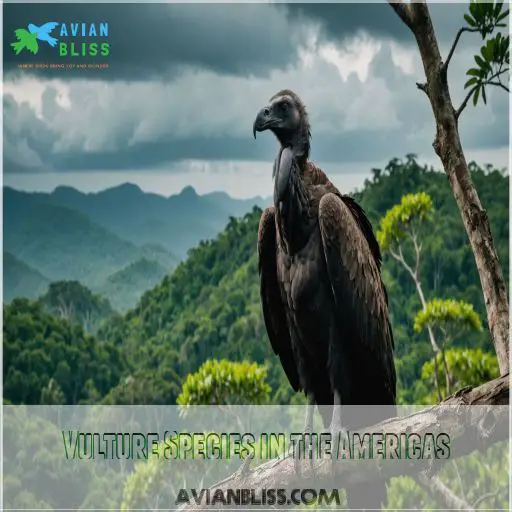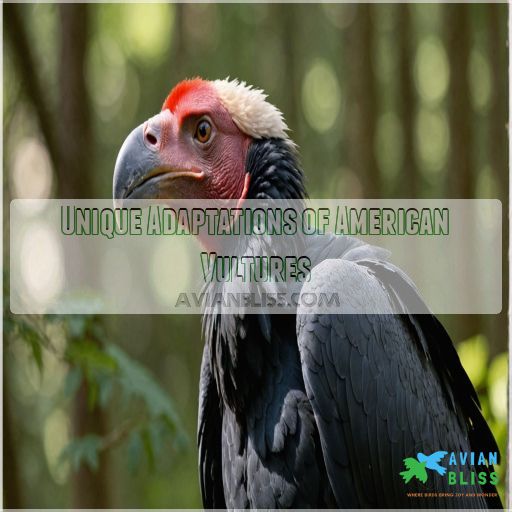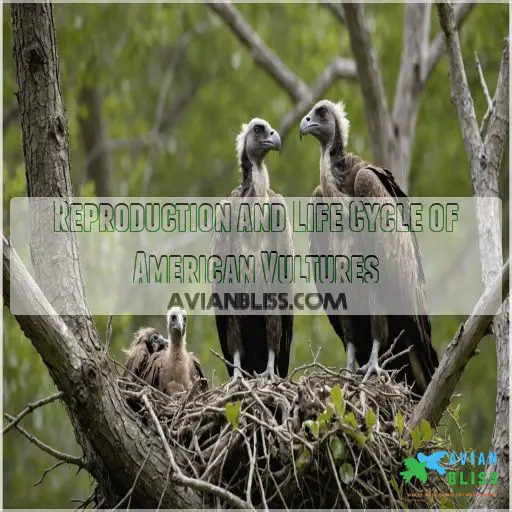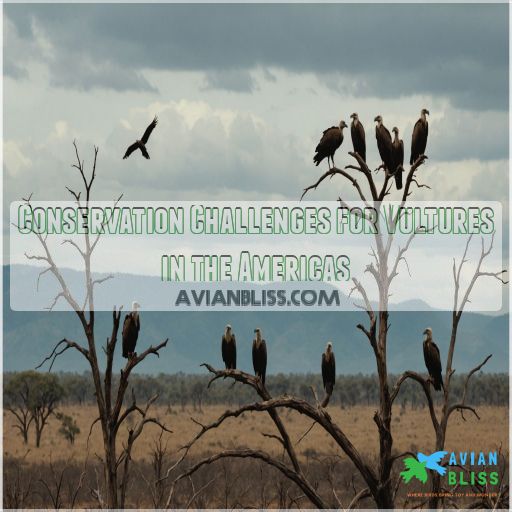This site is supported by our readers. We may earn a commission, at no cost to you, if you purchase through links.
 You’ve probably seen vultures soaring overhead, but did you know North, Central, and South America are home to some fascinating vulture species like the Turkey Vulture, Black Vulture, and California Condor? These New World vultures are nature’s clean-up crew, munching on carrion and keeping ecosystems tidy.
You’ve probably seen vultures soaring overhead, but did you know North, Central, and South America are home to some fascinating vulture species like the Turkey Vulture, Black Vulture, and California Condor? These New World vultures are nature’s clean-up crew, munching on carrion and keeping ecosystems tidy.
Turkey vultures have an incredible sense of smell, a rarity among birds, while Black Vultures prefer using their eyes or even following their turkey cousins.
California Condors, once on the brink of extinction, are making a comeback thanks to conservation efforts.
Curious about how vultures adapt to their unique roles in the wild? Stay tuned!
Table Of Contents
- Key Takeaways
- Vulture Species in the Americas
- Unique Adaptations of American Vultures
- Habitat Preferences of North and South American Vultures
- Feeding Behaviors and Ecological Role
- Reproduction and Life Cycle of American Vultures
- Conservation Challenges for Vultures in the Americas
- Frequently Asked Questions (FAQs)
- What vultures are native to North America?
- What is the largest vulture in South America?
- Are there vultures in Brazil?
- What are vultures called in the South?
- How do vultures find their food in nature?
- What are common threats to vulture populations?
- How do vultures help in waste management?
- What distinguishes New World vultures from others?
- Why do vultures have bald heads?
- Conclusion
Key Takeaways
- You’ll find a diverse cast of vulture characters across the Americas, from the red-headed Turkey Vulture to the critically endangered California Condor, each playing a starring role in nature’s cleanup crew.
- These feathered sanitation workers have some pretty quirky adaptations up their sleeves (or should we say, wings?). From their bald heads for mess-free dining to their stomach acid that could rival a chemistry lab, vultures are nature’s ultimate recycling machines.
- Don’t let their reputation fool you – vultures are the unsung heroes of disease control. By chowing down on carrion, they’re not just filling their bellies; they’re keeping ecosystems healthy and helping to prevent the spread of nasty pathogens.
- While these birds might seem tough as nails, they’re facing some serious challenges. From lead poisoning to habitat loss, vultures need our help. By understanding their crucial role and busting myths about these misunderstood birds, you can play a part in ensuring they continue to soar through American skies for generations to come.
Vulture Species in the Americas
You’ll find a diverse array of vulture species across the Americas, each with unique characteristics and adaptations.
From the widespread turkey vulture to the critically endangered California condor, these New World vultures play essential roles in their ecosystems as nature’s clean-up crew.
New World Vultures Vs. Old World Vultures
Despite their similar appearances, New World and Old World vultures aren’t closely related.
You’ll find New World vultures in the Americas, while their Old World cousins inhabit Africa, Asia, and Europe.
These birds evolved separately, developing unique traits, such as differences in their feeding strategies. For instance, New World vultures can’t vocalize beyond hisses and grunts, while Old World vultures are quite chatty.
Their ability to locate food differs too – some New World vultures use smell to locate food, a rare ability in birds.
Black Vulture Distribution and Characteristics
The black vulture, a sooty scavenger, is expanding its range across North and South America (Source). You’ll spot these compact birds with their distinctive white wingtips soaring high in the sky.
Here are five key characteristics:
- Broad wings and short tails for powerful flight
- Social behavior, often sharing food with family
- Adaptable to urban environments
- Poor sense of smell, relying on sight and other vultures
- Aggressive nature, sometimes displacing turkey vultures
Turkey Vulture Range and Identification
You’ll spot Turkey Vultures soaring gracefully across North America, their wings held in a shallow V, similar to Golden Eagles in North America Golden Eagles habitat
.
These large birds, with wingspans up to 6 feet, stand out with their dark bodies and bright red heads.
They’re masters of migration, some traveling as far as South America.
Unlike their black-headed cousins, Turkey Vultures have an extraordinary sense of smell, helping them locate carrion from great heights.
California Condor: a Critically Endangered Species
Soaring back from the brink of extinction, California condors embody a remarkable conservation success story. Once down to just 22 individuals in 1987, these majestic birds now number around 500 (Source).
Here’s what makes them so special:
- Largest land bird in North America, with a 9.5-foot wingspan
- Critically endangered, protected by law since 1967
- Captive breeding programs spearheaded their recovery
- Lead poisoning remains their biggest threat
King Vulture in Central and South America
Majestic king vultures soar over the lush forests of Central and South America, much like the golden eagles soaring through Arizona’s skies
.
These colorful scavengers have a thick beak and long claws perfect for tearing into carrion.
Though they may seem intimidating, king vultures play a key role in the ecosystem by consuming carrion and preventing disease spread through their vital role in ecosystem cleaning
.
Unique Adaptations of American Vultures
You’ll find vultures in the Americas have some fascinating tricks up their wings, like using bald heads for feeding cleanliness.
They have strong stomach acid to digest bacteria-laden carcasses.
These scavengers also "cool off" by urinating on their legs and even vomit to fend off predators.
Bald Heads: Evolution for Cleanliness
Before discussing powerful beaks, consider why vultures have bald heads—an evolutionary advantage. These feather-free benefits help with hygiene, preventing messy feathers after feeding. The head-feather tradeoff helps to keep the head clean when dining on carrion, avoiding blood stains and maintaining hygiene benefits.
Who knew a hairstyle choice could be so practical?
- Evolutionary Advantage: Keeps the head clean.
- Hygiene Benefits: Avoids feather soiling.
- Feather-Free Benefits: Easier maintenance.
Powerful Beaks and Weak Talons
While bald heads give vultures a clean edge, their powerful beaks expertly tear through carrion, offering an evolutionary advantage in their feeding strategy.
Despite their weak talons, they efficiently access prey selection, relying more on beak strength.
The sharp, hooked beak guarantees they thrive in their role as nature’s cleanup crew, highlighting unique adaptations in talon use and carrion access.
Urination for Thermoregulation and Disinfection
You might find it odd, but vultures urinate on their legs for a good reason.
This unique cooling mechanism helps them manage heat stress and serves an evolutionary advantage.
Their urination frequency cools them but also controls bacteria picked up from carcasses.
It’s like wearing a two-in-one gadget for both comfort and hygiene .
Strong Stomach Acid for Carrion Consumption
Just as vultures urinate for thermoregulation and disinfection, their strong stomach acid helps them safely consume carrion.
This acid adaptation with a pH near 0 aids in carrion digestion but also breaks down bacteria, neutralizing harmful pathogens like anthrax and botulism.
This impressive stomach acidity makes their meal choices surprisingly safe for their digestive systems.
Vomiting as a Defense Mechanism
Ever faced with danger, vultures have a unique ace up their featherless sleeves: vomiting.
This defense mechanism deters predators with foul-smelling, acidic vomit.
It’s an unexpected escape strategy that also serves as a weight reduction and distraction tactic.
So, don’t underestimate their talents—vultures know precisely when to use the art of vomiting for survival.
Habitat Preferences of North and South American Vultures
You might be surprised to learn that vultures in North and South America have adapted to thrive in a wide variety of habitats, from urban areas to remote mountain peaks.
While black vultures often make themselves at home in human-populated regions, turkey vultures and California condors prefer more natural settings like forests, grasslands, and open skies, particularly in environments with more open skies.
Black Vulture Urban Adaptation
Every scavenger needs a toolkit, and the Black Vulture has urban adaptation down to a science. These birds excel at trash can foraging and urban nesting, thriving in cities from South America to the United States.
Their nesting sites often include abandoned buildings, rocky crevices, and even ground-level sites like hollow logs, which provide them with the necessary safety and convenience black vulture nesting habits. This adaptability allows them to coexist with humans in a variety of environments.
Amid growing human interaction, their population growth raises concerns about disease impact. Turns out, vultures are road warriors with wings!
Turkey Vulture’s Diverse Habitat Range
While black vultures embrace urban settings, turkey vultures showcase an impressively diverse habitat range.
You’ll find them:
- Soaring in deserts or arid habitats
- Nesting within forests or woodlands
- Roosting near urban or suburban areas
- Migrating from Canada to South America
- Facing conservation challenges
These resourceful scavengers adapt nearly anywhere, reminding us — their wingspan covers vast distances, just like their habitats.
California Condor’s Specific Habitat Requirements
Unlike the adaptable turkey vulture, California condors need specific habitats.
You’ll find them nesting on cliff faces or tall tree snags, favoring open areas for foraging. These majestic birds depend on wind patterns to glide vast distances, sometimes over 250 miles a day.
Conservation efforts focus on minimizing human impact and ensuring steady food availability to support their fragile populations, which are often threatened by habitat loss and competition from native species. a 3-5 word contextual phrase
.
King Vulture’s Tropical Forest Dwelling
Imagine soaring through the lush tropical forests. That’s the King Vulture’s domain, where they thrive in their tropical habitat (Souther Mexico range)
. You’ll find them feasting on carcasses high above or lounging in the forest canopy. Their diet includes both large and small animal carcasses.
- Adapted for the forest canopy
- Prefers larger carcasses
- Faces predator threats
- Conservation challenges abound
Roosting and Nesting Site Selection
The King Vulture enjoys tropical forests, where nest site competition isn’t fierce.
When selecting spots for roosting and nesting, you’ll find safety factors come into play greatly. Vultures prefer elevated sites with available nesting materials, ensuring eggs stay protected.
Their diverse habitat selection includes both dense forests and open landscapes, balancing roosting dynamics with environmental safety.
Feeding Behaviors and Ecological Role
You’re about to discover how vultures’ unique feeding behaviors make them the unsung heroes of nature’s clean-up crew.
They play a vital role in maintaining healthy ecosystems by preventing the spread of disease.
Turkey Vulture’s Superior Sense of Smell
While other vultures rely on their keen eyesight, turkey vultures have developed an extraordinary sense of smell.
Their large olfactory bulbs allow them to detect even the faintest scent of carrion from over a mile away, giving them a distinct evolutionary advantage in locating fresh food sources .
This superior olfaction helps the turkey vulture thrive as nature’s clean-up crew across the Americas.
Black Vulture’s Reliance on Sight and Social Cues
You’ll discover that black vultures rely heavily on sight and social cues. They watch other vultures and join feeding frenzies.
Social hierarchy impacts their:
- Flock dynamics: They gather in groups to locate food.
- Food competition: They often outcompete lone scavengers.
- Roosting behavior: They exhibit strong roost fidelity.
- Urban adaptation: They thrive in cities, benefiting from human waste.
California Condor’s Scavenging Patterns
How does the California condor fit into the scavenging scene?
Its carrion preference helps it avoid food competition with predators. You might find them feasting on deer or even marine mammals.
They also consume bones for calcium, especially for nestling feeding.
Conservation efforts, including a detailed recovery plan, aim to secure their place in the ecosystem.
Vultures as Nature’s Clean-up Crew
Imagine vultures swooping down, acting like nature’s janitors. They feast on carrion, offering:
- Important carrion importance
- Essential ecosystem impact
- Intense vulture competition
- Interesting human perception
Their keen sense of smell allows them to detect ethyl mercaptan released by decaying flesh, making them efficient consumers of fresher carcasses. This unique adaptation is important in their role as nature’s cleanup crew.
These birds prevent waste buildup, ensuring a cleaner environment. You might spot them squabbling over scraps, but remember, they’re just doing their job—keeping nature tidy with every meal.
Impact on Disease Control in Ecosystems
Vultures play a pivotal role in ecosystem sanitation by removing decaying carcasses, thereby helping control bacteria and disease spread.
These natural clean-up crews benefit both humans and wildlife, maintaining balance and safety.
Their ability to consume carcasses without contracting diseases highlights their ecological importance.
| Benefit | Audience | Result |
|---|---|---|
| Disease Control | Humans | Reduced outbreaks |
| Bacteria Control | Wildlife | Healthier populations |
| Carcass Removal | Ecosystem | Cleaner environments |
Reproduction and Life Cycle of American Vultures
You’ll find that American vultures have intriguing nesting habits, often choosing secluded spots like cliffs or tree cavities for optimum protection.
As you explore their life cycle, you’ll see both parents work together to incubate bald eagle eggs and feed their chicks, ensuring the young are ready to take flight in about ten weeks
.
Nesting Habits and Site Selection
You’d find vultures nesting in unexpected spots like hollow trees, cliffs, or even abandoned buildings, shunning traditional nests.
Nesting materials are minimal—often just debris for eggs.
Site security is essential, so they choose secluded places to shield eggs and chicks.
Surprisingly, they may reuse nests yearly, adapting to climate impacts with unwavering parental defense strategies .
Egg Laying and Incubation Periods
From the comfort of their chosen nest sites, vultures lay eggs that vary in size and hue—often creamy white with specks of color.
The incubation period, lasting 28 to 45 days, keeps parents vigilant as they maintain egg warmth and safety. Knowing each minute matters in this delicate lifecycle journey connects you to nature’s resilient rhythm .
Parental Care and Chick Development
American vultures are fascinating creatures when it comes to parental care.
You’ll witness these interesting behaviors:
- Nestling feeding occurs through regurgitation.
- Brood size typically consists of 1-3 chicks.
- Parental roles are shared equally, ensuring safety.
- Incubation duration ranges from 28 to 40 days.
It’s a wonder how these birds juggle life and family.
Fledging and Juvenile Behavior
After chicks flourish under parental care, young vultures begin their first flight, a thrilling leap into independence.
These fledglings begin testing their wings, driven by curiosity and survival instincts.
Parental feeding extends until they gain fledgling independence.
As juveniles, they face sibling rivalry and eventually venture into juvenile dispersal, exploring new territories while honing scavenging skills.
Lifespan and Reproductive Maturity
Watching young vultures master flight, you might wonder about their next milestones. Lifespan varies, with some reaching 20 years.
They achieve reproductive maturity between 4 and 5 years.
Breeding success hinges on nesting strategies and dedicated parental care. Both parents incubate eggs and feed chicks, ensuring survival.
With strong family bonds, vultures certainly show they’re not just scavengers.
Conservation Challenges for Vultures in the Americas
You might think vultures in the Americas have an easy life, but they face serious threats.
There are several challenges to their survival, including habitat loss and lead poisoning.
Additionally, wind turbine collisions and human misconceptions also pose significant challenges, making their survival anything but a picnic.
Habitat Loss and Fragmentation
Imagine you’re a vulture, soaring high only to find your habitat disappearing beneath you.
As a key part of the ecosystem, vultures like the black vulture, play a significant role in cleaning up carrion, turning waste into energy and contributing to ecosystem health.
Urban sprawl and habitat fragmentation severely impact vulture populations by isolating groups, making survival a high-wire act without a safety net.
To combat this decline, conservation strategies include protecting areas important for roosting and feeding, ensuring vultures continue their vital ecosystem role.
Lead Poisoning From Hunting Ammunition
You may not realize it, but the lead ammunition used by hunters is poisoning vultures across North and South America.
These scavengers ingest lead fragments when feeding on carcasses, leading to sickness and death.
Thankfully, many states now incentivize hunters to use non-toxic alternatives, helping protect these important cleanup crews.
Wind Turbine Collisions and Electrocution
Lead poisoning isn’t the only threat. Vultures face danger from wind turbine collisions and electrocution, impacting populations greatly.
Want to save these scavengers? Consider:
- Wind turbine design: Make them bird-friendly.
- Bird flight patterns: Study and adapt designs.
- Risk mitigation strategies: Implement shutdowns.
- Conservation efforts: Support projects that insulate power lines and reduce electrocutions.
Human Persecution and Misconceptions
Vultures often face human persecution due to myths about them spreading disease, though they actually help control it.
Misunderstandings, like associating them with bad omens, fuel these actions.
Ethical hunting practices, like avoiding lead ammunition, support vulture conservation by preventing lead poisoning.
By recognizing their ecological value, you contribute to curbing habitat destruction and creating coexistence solutions.
Frequently Asked Questions (FAQs)
What vultures are native to North America?
Think vultures aren’t interesting?
North America hosts three unique species: Turkey Vultures with red heads, Black Vultures with black heads, and the magnificent California Condors.
Their ecological role as nature’s clean-up crew is irreplaceable.
What is the largest vulture in South America?
You’ll find the Andean Condor reigning supreme in South America’s skies.
This behemoth boasts a wingspan up to 275 cm (108 in) and weighs around 11 kg (24 lb).
It’s nature’s aerial giant, soaring majestically over the Andes.
Are there vultures in Brazil?
Brazil’s skies host several vulture species, including the American Black Vulture.
You’ll spot these large, dull-black birds soaring on flat wings or congregating near cities and open areas.
They play a vital role in nature’s cleanup crew. (Source)
What are vultures called in the South?
Vultures in the South are commonly known as "buzzards."
These large scavengers play a vital role as nature’s cleaning crew, ridding the environment of carcasses.
You’ll often spot turkey vultures and black vultures soaring on thermal currents, keeping watch over the landscape.
How do vultures find their food in nature?
Nature’s cleanup crew soars on thermal currents, their keen noses detecting decay from a mile away.
You’ll find these featherless-headed scavengers circling above, sniffing out fresh carcasses with their extraordinary olfactory system .
They’re nature’s efficient recyclers, keeping ecosystems clean.
What are common threats to vulture populations?
You’ll find vultures face a barrage of threats.
Illegal poisoning tops the list, wiping out entire colonies in one fell swoop.
Lead bullets, roadkill-related accidents, and certain veterinary drugs also pose significant risks to these nature’s clean-up crew.
Certain risks to these birds also include being harmed by Lead bullets.
How do vultures help in waste management?
Ever wondered how nature keeps itself clean?
Vultures act as nature’s cleanup crew, efficiently disposing of carrion. They consume decaying flesh, preventing disease spread and recycling nutrients.
These airborne sanitation workers maintain ecosystem health and balance .
What distinguishes New World vultures from others?
New World vultures stand out with their unique traits.
They cool themselves by defecating on their legs, lack voice boxes, and rely on smell to find food.
Unlike their Old World cousins, they can run and don’t build nests.
Why do vultures have bald heads?
Balding isn’t just for middle-aged men.
Vultures sport their sleek, featherless domes for practical reasons.
It’s not vanity – it’s survival. Their bald heads help them stay clean while feasting and cool off in hot weather.
Conclusion
Well, there you have it – the lowdown on vultures in North, Central, and South America.
These birds may not win any beauty contests, but they’re the unsung heroes of our ecosystems.
From their unique adaptations to their vital role in nature’s clean-up crew, vultures are truly fascinating creatures.
Next time you spot one soaring overhead, remember: these often misunderstood birds are working hard to keep our environment healthy.
So let’s give these remarkable scavengers the respect and protection they deserve.









